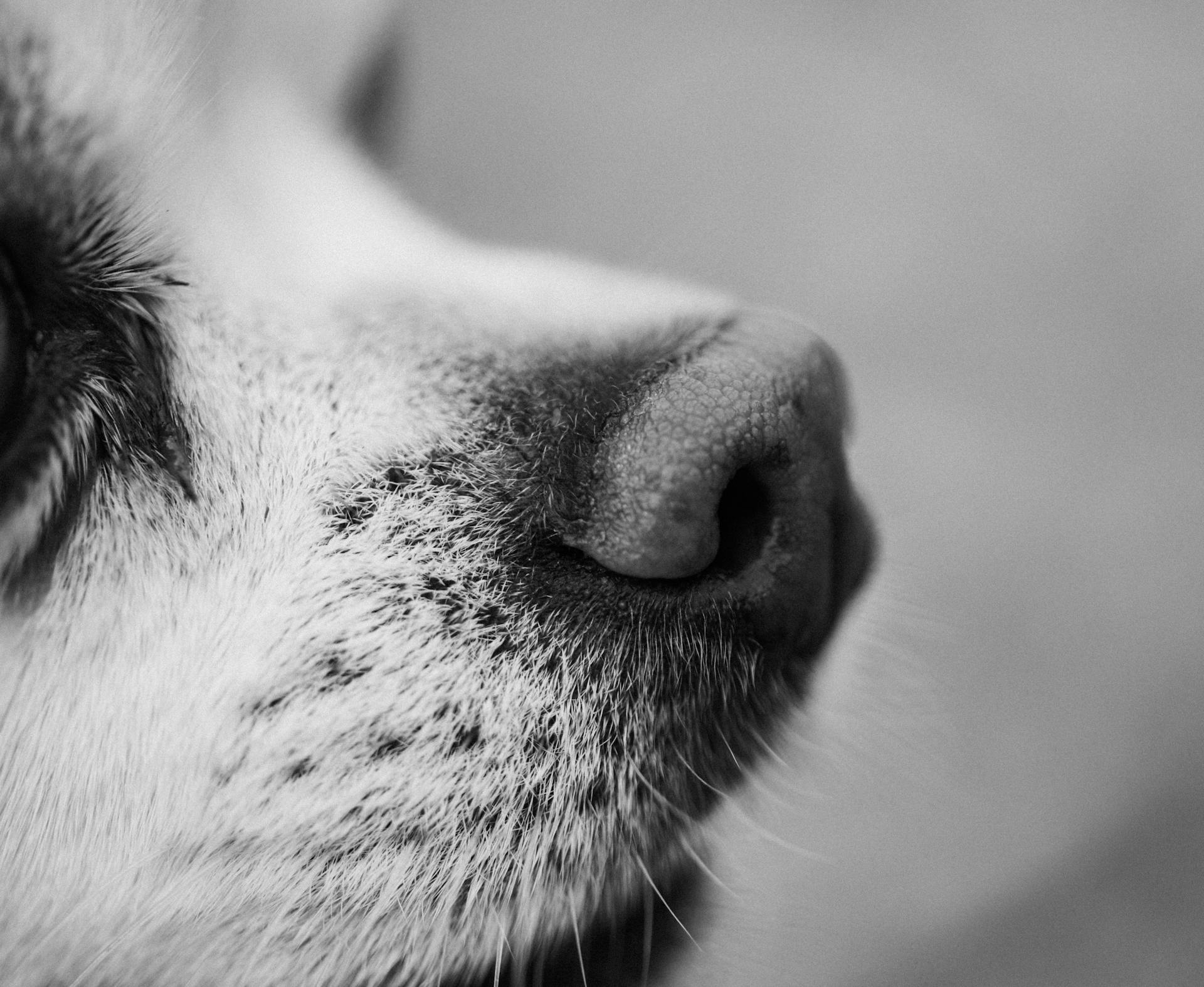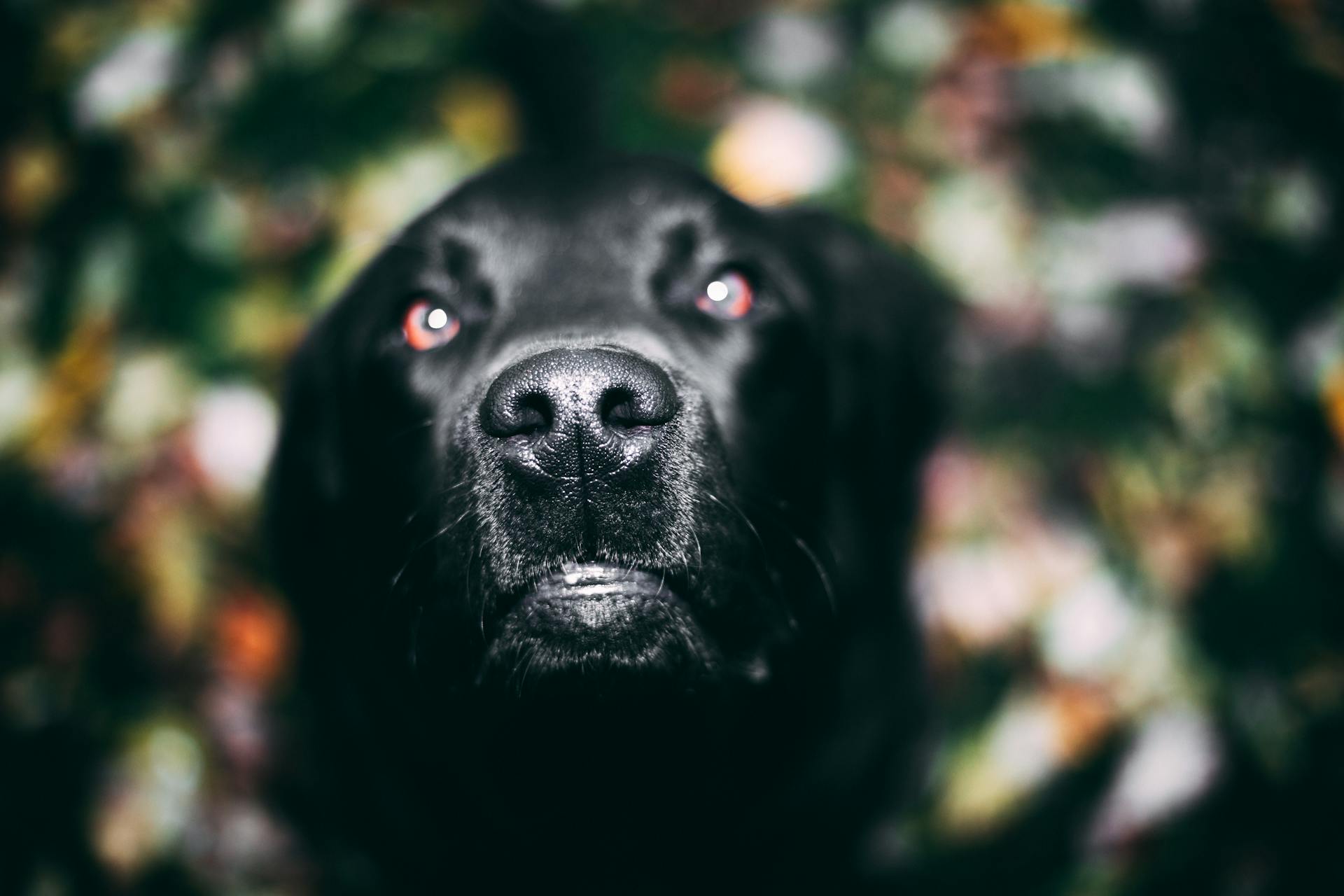
Dogs can develop allergies to environmental substances like pollen, dust, and mold, which can cause chronic nasal issues.
Some common signs of allergies in dogs include sneezing, runny noses, and excessive paw licking.
Pollen is a common allergen that can trigger nasal problems in dogs, especially during peak pollen seasons.
Allergies in dogs can be managed with the right treatment and care, including regular grooming and hygiene practices.
Consider reading: Pollen Allergies in Dogs
What Are Allergies?
Allergies in dogs are a common issue that can cause a lot of discomfort and distress. An allergy is a state of over-reactivity or hypersensitivity of the immune system to a particular substance called an allergen.
Most allergens are proteins from plants, insects, animals, or foods. Exposure to the allergen, usually on multiple occasions spanning months to years, sensitizes the immune system.
The immune system mistakenly identifies harmless substances as threats, leading to a variety of physical symptoms. This can range from mild discomfort to severe, life-threatening conditions.
The immune reactions involved in allergies are complex and involve allergen protein molecules combined with antibodies in the blood that attach to a cell called a mast cell. Mast cells are found in many tissues throughout the body.
Local inflammation, such as redness, swelling, and itching, can occur when the antigen and antibody react with mast cells. This inflammation causes various signs associated with an allergic reaction.
Symptoms and Reactions
Dogs with allergies can exhibit a range of symptoms, from mild to severe, and it's essential to recognize these signs to provide proper care.
Itchy skin is one of the most noticeable signs of allergies in dogs, with persistent scratching, biting, or licking leading to redness and irritation, often concentrated around the face, feet, and ears.
Skin rashes and hives can also occur, with red, inflamed patches or raised welts, particularly after exposure to a potential allergen.
Chronic ear infections are common in dogs with allergies, with symptoms including head shaking, ear scratching, redness inside the ear, and sometimes an unusual odor or discharge.
Here's an interesting read: Allergies for Dogs Scratching
A runny nose and watery eyes are similar to human allergies, caused by inhaled allergens like pollen or dust.
Sneezing is another sign of airborne allergies in dogs, often more pronounced in certain environments or seasons.
Dogs with allergies might constantly lick or chew their paws due to itchiness, which can lead to discoloration of the fur on their paws from excessive licking.
Some dogs may experience digestive issues, such as vomiting, diarrhea, or gas, due to food allergies or sensitivities.
Hair loss and bald patches can occur due to constant scratching and licking, leading to visible bald spots on their coat.
Hot spots are areas on the dog's skin that become inflamed, sore, and infected, usually very painful and can spread rapidly.
Breathing difficulties can occur in some dogs with allergies, particularly if they are allergic to inhaled substances like pollen or smoke.
Behavioral changes can be a sign of uncomfortable allergy symptoms, including restlessness, agitation, or a decrease in overall activity levels.
Here are some common symptoms of allergies in dogs:
- Itchy skin (pruritus)
- Skin rashes and hives
- Chronic ear infections
- Runny nose and watery eyes
- Sneezing
- Paw chewing/licking
- Digestive issues
- Hair loss and bald patches
- Hot spots
- Breathing difficulties
- Behavioral changes
Types and Prevalence
Dogs can have allergies just like humans, and understanding the different types and prevalence of allergies is crucial for effective management and treatment. Common dog allergies fall into a few primary categories, including environmental allergies, food allergies, flea allergy dermatitis, skin allergies, and contact allergies.
Environmental allergies are triggered by allergens found in a dog's surroundings, such as pollen, mold, dust mites, and grass. These allergies often cause seasonal symptoms, but indoor allergens can cause year-round issues.
According to the statistics, most allergies appear after the pet is six months of age, with the majority of affected dogs over the age of one or two. This is because it takes time for the body to become "sensitized" to the substance the pet is allergic to.
Here's a breakdown of the different types of allergies and their prevalence:
Are Inherited?
Allergies can be genetic, and certain breeds are more predisposed to developing allergies. This means that a dog's genetic makeup can make them more susceptible to developing allergic reactions.

While not all allergies are directly inherited, a dog's genetic predisposition can play a significant role in their likelihood of developing allergies. Unfortunately, this means that some dogs may be more prone to allergies due to their breed or genetic makeup.
Most allergies appear after a pet is six months of age, which is a crucial time to monitor your dog's health and behavior. This is because it takes time for the body to become "sensitized" to the substance the pet is allergic to.
Expand your knowledge: Can You Pierce a Dog's Nose?
Airborne Atopy
Airborne atopy is a common type of allergy in dogs. It's triggered by allergens found in the air, such as pollen, mold, and dust mites.
Dogs with airborne atopy often suffer from seasonal symptoms, but indoor allergens can cause year-round issues. This type of allergy can cause a range of symptoms, including itchy skin, skin rashes, and respiratory problems.
Some common signs of airborne atopy in dogs include sneezing, runny eyes, and a runny nose. These symptoms can be similar to those experienced by humans with allergies.
Intriguing read: Most Common Dog Diseases
Dogs with airborne atopy may also exhibit behavioral changes, such as restlessness and agitation. If you suspect your dog has airborne atopy, it's essential to consult with a veterinarian for proper diagnosis and treatment.
Here are some common environmental allergens that can trigger airborne atopy in dogs:
- Pollen
- Mold
- Dust mites
- Grass
Keep in mind that each dog is unique, and what might be a harmless irritant to one dog could be a significant allergen for another.
Diagnosis and Treatment
Diagnosing allergies in dogs involves a comprehensive evaluation by a veterinarian, including a review of the dog's medical history and physical examination.
A veterinarian may use specific allergy tests such as blood tests or skin prick tests to help identify the allergy. These tests can help determine the specific allergen causing the reaction.
An elimination diet may be used to identify food allergies in dogs. This involves removing common allergenic foods from the dog's diet for a period of time to see if symptoms improve.
Check this out: Dogs with Pancreatitis Diet
General Information
Dogs can develop allergies in their noses, which can cause symptoms like sneezing, runny eyes, and itchy skin.
The most common allergens that trigger nasal allergies in dogs are pollen, dust mites, and mold.
Dogs with nasal allergies may also experience a runny nose, congestion, and loss of smell.
The nasal passages of dogs are much smaller than those of humans, making them more susceptible to allergic reactions.
Some breeds, such as Pugs and Bulldogs, are more prone to nasal allergies due to their flat faces and narrow airways.
Regular grooming and cleaning of your dog's living space can help reduce exposure to allergens.
See what others are reading: Kennel Cough Nasal Discharge
Atopic Dermatitis
Atopic Dermatitis is a type of environmental allergy that affects many dogs. Atopic dogs often have severe symptoms and are affected for multiple seasons of the year.
Typically, dogs with atopic dermatitis have allergies to multiple environmental factors. These dogs require more aggressive management and often need to stay on allergy medications all year long.
You might like: Environmental Allergies Dogs
Dogs with atopic dermatitis often show a reddish-brown staining of the fur caused by saliva or a red rash due to skin irritation or secondary infection. This is especially noticeable on light-colored dogs.
It's challenging to determine the specific cause of a dog's allergies, but keeping a log of the seasonality of their allergies can help identify patterns and guide a treatment plan.
Frequently Asked Questions
How to clear a dog's nasal passage?
Clear your dog's nasal passage by gently wiping away nasal discharge with a soft damp towel or by using a humidifier, vaporizer, or hot shower to loosen congestion
What can I give my dog for nasal congestion?
For nasal congestion in dogs, use a humidifier with plain filtered water or saline, or create a steamy environment by having them inhale the bathroom steam while someone takes a hot shower.
Sources
- https://www.whole-dog-journal.com/health/when-to-worry-about-your-dogs-runny-nose/
- https://vcahospitals.com/know-your-pet/allergy-general-in-dogs
- https://www.merckvetmanual.com/dog-owners/skin-disorders-of-dogs/allergies-in-dogs
- https://urgentvet.com/allergies-in-dogs-symptoms-treatment/
- https://www.ctvsh.com/services/dogs/blog/allergies-dogs-what-you-need-know
Featured Images: pexels.com


